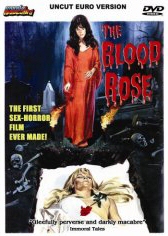
Widely acknowledged (or more truthfully, often claimed as) the 'first film to combine eroticism and terror,' The Blood Rose is certainly one of the more stylish. And while Jess Franco was crafting his own peculiar marriages of death and Eros before this orgy of sensationalism, not even his erotic sojourns into Hades match then lyricism and poetry of this. Marrying sex and death, terror and desire, this surrealistic exploration tackles Faustian desires, medical science, and deranged psychology in the same breath. Forever changing the manner in which we viewed the aesthetic and intellectual parameters of the genre, Blood Rose's sexually charged images of violence and Gothicism continues to inform artists. Director Claude Mulot made an adult faerie tale of pathos, inspiring the language of terror by making it both more intimate. Mondo Macabro resurrects this atmospherically charged nightmare in a bold new transfer, allowing this elegy of funereal romance and savagery to be seen in all its sinful splendor.
Borrowing from, and building upon, the central premise and tones of both The Awful Dr. Orloff and Blood and Roses, (and a member of the Eyes Without a Face medical thriller family), The Blood Rose successfully combines elements of the mad medical thriller, gothic romance, and eroticism into a cold and consciously distanced hybrid. The plot approaches such intimate subjects as love, victimization, and exploitation in a manner ghostly in feeling while realistic in conception, lending a dreadful air of possibility to the funeral proceedings. Frederic Lansac, a famed painter well known in society, goes mad when his new bride's face is hideously disfigured from her leap into a bonfire. Determined to restore her beauty (similarly to Franco's Orloff, Faceless, etc), Frederic searches for a notorious plastic surgeon whose past activities ran him afoul from authorities. Using Lansac's remote gothic-inspired castle as a centre of operations, both men seduce, imprison, and subject attractive young girls to horrific experiments.
A fable of desire and pain, this orgy of sin and semen was a triumph of popular storytelling with undeniable artistic leanings. Never forgetting that his first duty is to entertain, Mulot cloaks his expressionistic picture in layers of mood, exploiting to feverish effect the controversial nature of love and power struggle. This decadent opera offers unrepentant bloodshed and gratuitous nudity, but it does so with style and cold elegance, the latter of which is supported by the colors and tone. Atmosphere is essential, as blood reds and moody blues drift like damned spirits over voluptuous flesh. While one is encouraged to enjoy the action at face value, deeper meanings/themes are available beneath the erotic carnage. Love is exposed in this story not as a saving grace or thing of wonder, but as a trap, a death of individuality and personal will. Beauty and the grotesque are juxtaposed to reflect the seemingly paradoxical similarities that exist between them. Both the story and its presentation injects sophisticated sensuality into themes usually associated with death, altering the meanings and implications of both desire and mortality. A wondrous exercise in overflowing imagery, Blood Rose emphasizes mood rather than narrative, coating characters and action in the symbolism of expressionism. Influencing death-and-desire operas of Jean Rollin and Jess Franco, Mulot's vision is amoral, adding to its sense of fear and fatalistic philosophy. Generous doses of gore and skin serve as both eye candy and thematic contrasts to the images of decaying castles and crumbling aristocracy. Most impressive is the manner in which the gothic imagery and medical terrors are used not only as powerfully disturbing images but as metaphors for real life relationships. Mulot focuses on the frailty of appearances and the deceptions of love. Relationships are every bit as much monsters as the undead. The director's inventive compositions infiltrate the intense manoeuvrings between people with the haunting opulence of an opium fantasy.
A long sought for rarity among horror film collectors, The Blood Rose is presented by Mondo Macabro on DVD for the first time, completely uncut and re-mastered! Presented in an aspect ratio of 1.66:1 (16×9 enhanced), the picture is crisp and clean, re-producing the film's gingerbread color scheme with clarity, although the age of the print occasionally betrays itself. Audio is presented in English and French languages with optional English subtitles. Both languages are largely disturbance free, clean and provocative.
Extras for this wonder of elegiac decadence include an "Interview with Didier Philippe-Gérard," an assistant to Blood Rose director Claude Mulot, who provides a fascinating history of the film's production as well as the cinema of France in the 70s and 80s. Of further interest are generous production notes by Pete Tombs exploring the history of the erotic French horror film, a rare still/poster gallery, and the ever-popular MM Preview Reel.
Review by William P. Simmons
| Released by Mondo Macabro |
| Region 1 - NTSC |
| Not Rated |
| Extras : |
| see main review |